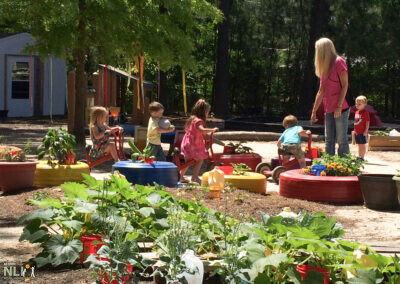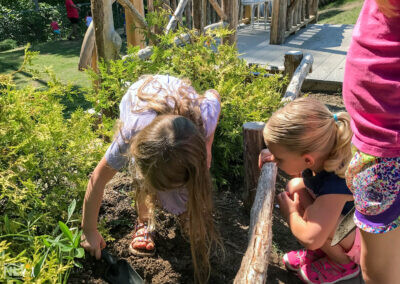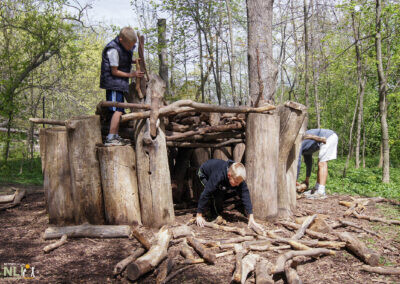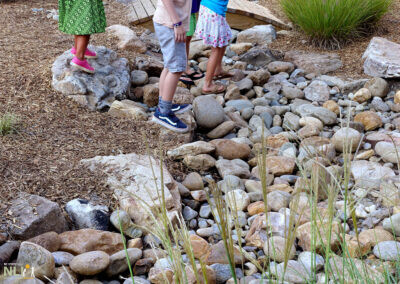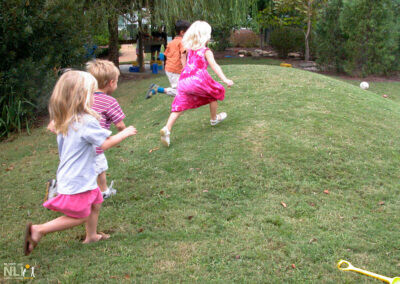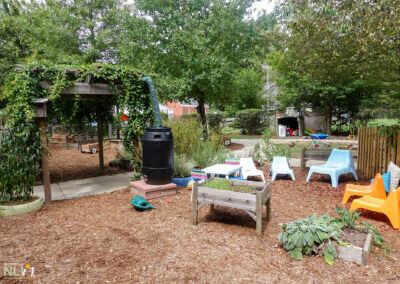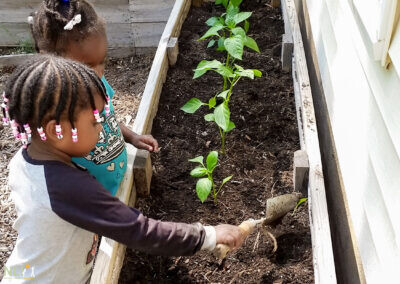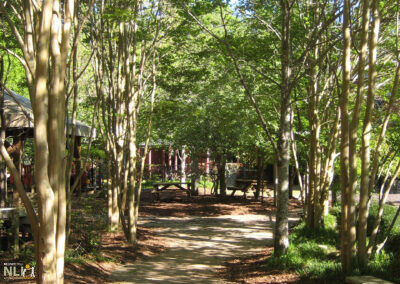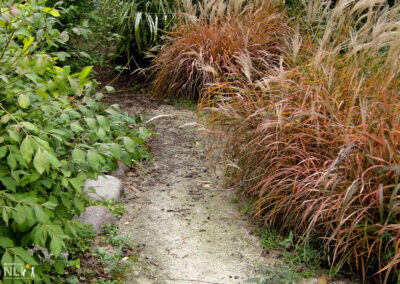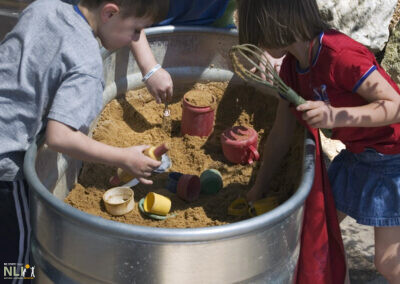Infosheets
01. Benefits of Engaging Children with Nature
Naturalized outdoor learning environments (OLEs) stimulate the diversity of children’s play experiences and contribute to healthy childhood development. Best practice design of OLEs incorporates trees, shrubs, vines, flowers, grasses, edible fruits and vegetables to connect children with nature and diversify their outdoor experience. This Infosheet discusses the benefits of engaging children with nature and presents examples of simple ways to naturalize OLEs in childcare centers and schools.
WHY NATURALIZE OUTDOOR PLAY AND LEARNING ENVIRONMENTS?
Today’s children and families may have limited opportunities to connect with the natural environment. Richard Louv called this phenomenon “nature-deficit disorder” in his book The Last Child in the Woods, and opened the nation’s eyes to the positive effects that nature can have on children’s development. Louv documented how modern family life has changed dramatically in the last two decades. Children spend more time watching television and playing video games than they do being physically active outside.
Families are eating more processed, high-calorie foods due to their busy schedules. Family sit-down meals are becoming a rare event. These changes have helped lead to an epidemic of childhood obesity, which presents serious health threats including heart disease, diabetes, sleep apnea, and social and psychological problems. Today in North Carolina more than one-third of young children are considered overweight and obese.
In the past decade, the benefits of children engaging with nature have been well documented in numerous scientific research publications. Collectively, this body of research shows that children’s social, psychological, and physical health are positively impacted through daily contact with nature, including:¹
-
Supports multiple development domains.
Nature is important to children’s development in every major way—intellectually, emotionally, socially, spiritually and physically.
-
Supports creativity and problem-solving.
Studies of children in schoolyards found that they engage in more creative and cooperative forms of play. Play in nature is especially important for developing capacities for creativity, problem-solving, and intellectual development.
-
Enhances cognitive abilities.
Proximity, views of, and daily exposure to natural settings increases children’s ability to focus and enhances cognitive abilities.
-
Improves academic performance.
U.S. studies show that schools using outdoor classrooms and other forms of nature-based experiential education support significant student gains in social studies, science, language arts, and math. Students in outdoor science programs improved science testing scores by 27%.
-
Reduces Attention Deficit Disorder (ADD) symptoms.
Contact with the natural world can significantly reduce symptoms of ADD in children as young as five years old.
-
Increases physical activity.
Children who experience school grounds with diverse natural settings are more physically active, more aware of nutrition, more civil to one another, and more creative.
-
Improves nutrition.
Children who grow their own food are more likely to eat fruits and vegetables and to show higher levels of knowledge about nutrition. They are also more likely to continue healthy eating habits throughout their lives.
-
Improves eyesight.
More time spent outdoors is related to reduced rates of nearsightedness (also known as myopia), in children and adolescents.
-
Improves social relations.
Children will be smarter, better able to get along with others, healthier and happier when they have regular opportunities for free and unstructured play outside.
-
Improves self-discipline.
Access to green spaces, and even a view of green settings, enhances peace, self-control and self-discipline within inner city youth, and particularly in girls.
-
Reduces stress.
Green plants and vistas reduce stress among highly stressed children. Locations with a greater number of plants, greener views, and access to natural play areas show more significant results.
CHILDREN NEED VITAMIN “G”
“Green environments are an essential component of a healthy human habitat” according to Frances Ming Kuo, a researcher documenting the positive link between nature and human health and social and psychological functioning. Kuo summarizes various research studies that show that humans benefit from exposure to green environments (parks, forests, gardens, etc.) and conversely, people with less access to green places report more medical symptoms and poorer health. Kuo uses the phrase “Vitamin G” (G for “green”) to capture nature’s role as a necessary ingredient for a healthy life. Evidence suggests that, like a vitamin, contact with nature and green environments is needed in frequent, regular doses.
Resources
- For more information, including scientific references, see the NLI Research Brief: Impact of Early Childhood Outdoor Learning Environments (2019).
NATURALIZING OUTDOOR LEARNING AND PLAY ENVIRONMENTS
The majority of children are in childcare or school for extended periods of time, often eight to ten hours per day, which makes green environment vital to their physical and emotional well-being. Childcare centers and schools with naturalized outdoor environments allow children to have safe, ready-made access to green places and engagement with nature. A wide range of naturalized settings and elements stimulate a diversity of play and learning experiences for children, adding endless value to an outdoor environment.
NATURALIZED SETTINGS AND ELEMENTS
Multi-use lawns
support high-energy group games and the exuberant joy of running — activities that promote cooperation and gross motor development (Figure 5). Lawns provide an ideal space for play with balls and other types of mobile equipment that require a soft surface. Grassy areas can accommodate social gatherings such as story time, and offer a place for simply relaxing.
Gathering places
encourage children to meet and work together in small groups, stimulating social interaction and cooperative relationships. Such spaces can support art-making, storytelling, and science exploration (Figure 6).
Sun protection
is essential for the health and comfort of children outdoors. This can be achieved by installing medium-size trees, large shrubs, arbors, pergolas, tunnels, and trellises. When scattered throughout the play and learning area, they create frequent patches of shade and three-dimensional spaces scaled to children. Vine-covered teepees provide shade and an exciting play space.
Experience of edible landscape
offer an essential introduction to healthy eating. They include annual vegetable gardens and permanent edible landscape elements such as perennial vegetables, fruiting trees, shrubs, and vines. Gardens can be a small, single bed or a large managed garden of 200-300 square feet. Edible landscapes get children excited about eating fresh fruit and vegetables and connect them intimately with nature.
Pathways
promote active, play, and learning by providing children and teachers with easy access throughout the outdoor learning environment. Primary pathways stimulate vigorous activity, while secondary and tertiary pathways provide sensory interest and opportunities to explore (Figures 8 & 9).
Sand and mud play
allow children to move, mold, dig, sift, sculpt, and pour. Sand and mud are classic natural materials that provide a multitude of opportunities for creative play and social interaction (Figure 10).
Water play settings
create multi-sensory play opportunities. Water features allow children to interact with diverse objects, manipulate water flow with movable stones, pour with containers, splash, paint with water, and more. Primary methods of providing water play include elevated water tables (lower) or in-ground, hard-surfaced streams.

